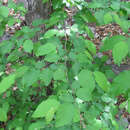en
names in breadcrumbs


Ostrya chisosensis ist ein kleiner Baum aus der Gattung der Hopfenbuchen (Ostrya). Das natürliche Verbreitungsgebiet der Art liegt in Texas in den Vereinigten Staaten. Nach R. Govaerts ist die Art aber ein Synonym von Ostrya knowltonii Coville.[1]
Ostrya chisosensis ist ein bis zu 12 Meter hoher Baum mit offener und zylindrischer Krone. Die Rinde ist graubraun und in vertikalen Streifen zerrissen. Die Zweige sind spärlich bis locker, jedoch nicht drüsig behaart. Die Laubblätter haben einen behaarten bis kahlen, nicht drüsig behaarten Stiel. Die Blattspreite ist 3,5 bis 5 Zentimeter lang und 2 bis 3 Zentimeter breit, breit-elliptisch bis elliptisch-lanzettlich, mit spitzer oder stumpfer Spitze, schmal gerundeter bis herzförmiger oder keilförmiger Basis und fein doppelt gesägtem Blattrand. Die Blattunterseite ist spärlich behaart, besonders entlang den Blattadern.[2]
Die männlichen Blütenstände sind 3 bis 4 Zentimeter lange, die weiblichen 0,8 bis 1,5 Zentimeter lange Kätzchen. Die Fruchtstände sind 2 bis 4 Zentimeter lang und haben Durchmesser von 1,5 bis 2,5 Zentimeter. Die Tragblätter sind 1 bis 1,8 Zentimeter lang und 0,5 bis 1 Zentimeter breit. Ostrya chisosensis blüht im Spätfrühling.[2]
Das natürliche Verbreitungsgebiet der Art liegt in Texas in den Vereinigten Staaten.[3] Man findet sie endemisch nur im Big-Bend-Nationalpark. Ostrya chisosensis wächst entlang von Flussläufen und auf feuchten Hängen in Höhen von 1500 bis 2300 Metern.[2]
Ostrya chisosensis ist eine Art aus der Gattung der Hopfenbuchen (Ostrya). Diese wird in der Familie der Birkengewächse (Betulaceae), der Unterfamilie der Haselnussgewächse (Coryloideae) zugeordnet.[3] Die Art wurde 1965 von Donovan Stewart Correll erstmals wissenschaftlich beschrieben.[3] Der Gattungsname Ostrya stammt aus dem Lateinischen und wurde schon von den Römern für die Hopfenbuche verwendet.[4]
Ostrya chisosensis ist ein kleiner Baum aus der Gattung der Hopfenbuchen (Ostrya). Das natürliche Verbreitungsgebiet der Art liegt in Texas in den Vereinigten Staaten. Nach R. Govaerts ist die Art aber ein Synonym von Ostrya knowltonii Coville.
Ostrya chisosensis, common name Big Bend hop-hornbeam or Chisos hop-hornbeam, is a plant species endemic to Texas. It is known only from the Chisos Mountains inside Big Bend National Park, in Brewster County, although related populations in northern Chihuahua have not been studied in detail and may be the same species. It grows along streambanks and on the walls of canyons.[3]
Ostrya chisosensis is a tree up to 12 m tall. Bark splits into narrow vertical strips. Leaves broadly elliptic to lanceolate, lacking glandular hairs. Staminate (male) catkins are 3.5–5 cm long.[3][4][5][6]
Ostrya chisosensis, common name Big Bend hop-hornbeam or Chisos hop-hornbeam, is a plant species endemic to Texas. It is known only from the Chisos Mountains inside Big Bend National Park, in Brewster County, although related populations in northern Chihuahua have not been studied in detail and may be the same species. It grows along streambanks and on the walls of canyons.
Ostrya chisosensis is a tree up to 12 m tall. Bark splits into narrow vertical strips. Leaves broadly elliptic to lanceolate, lacking glandular hairs. Staminate (male) catkins are 3.5–5 cm long.
Ostrya knowltonii là một loài thực vật có hoa trong họ Betulaceae. Loài này được Sarg. mô tả khoa học đầu tiên năm 1894.[4]
Ostrya knowltonii là một loài thực vật có hoa trong họ Betulaceae. Loài này được Sarg. mô tả khoa học đầu tiên năm 1894.
Ostrya knowltonii Sarg.
Охранный статусХмелеграб Нольтона (лат. Ostrya knowltonii) — вид деревьев рода Хмелеграб (Ostrya) семейства Берёзовые (Betulaceae).
В Северной Америке и в Англии в культуре с 1914—1916 годов.
В природе ареал вида охватывает Северную Америку.
Произрастает в горных лесах на высоте 1500—2000 м над уровнем омря.
Дерево высотой до 10 м, со стволом диаметром 30—40 см. На высоте 50 см от земли ствол, обычно, разветвляется на 3—4 прямостоячие крупные ветви. Ветви тонкие, висячие, часто искривлённые, образуют узкую закруглённую симметричную крону. Однолетние побеги опушённые, зеленовато-коричневатые; двулетние — голые, серые. Кора на внутренней стороне ярко-оранжевая, отслаивающаяся пластинками.
Почки яйцевидные, опушённые, тёмно-красно-бурые. Листья яйцевидные до овальных, длиной 2,5—5 см, острые или наверху закруглённые, с округлым или слегка сердцевидным основанием, остропильчатые, сверху тёмно-жёлто-зелёные и волосистые, снизу светлее и мягко опушённые.
Тычиночные серёжки длиной до 3 см, на толстых ножках, покрытых рыжеватым опушением; чешуйки постепенно суживающиеся в тонкое шиловидное острие, тёмно-бурые, опушённые. Пестичные серёжки длиной 3 см, с яйцевидно-ланцетными, светло-жёлто-зелёными опушёнными чешуйками, ресничатыми по краю.
Орешек продолговатый, длиной 6 мм, волосистый на верхушке.
Древесина светло-красновато-бурая с тонкой заболонью.
Вид Хмелеграб Нольтона входит в род Хмелеграб (Ostrya) подсемейства Лещиновые (Coryloideae) семейства Берёзовые (Betulaceae) порядка Букоцветные (Fagales).
Хмелеграб Нольтона (лат. Ostrya knowltonii) — вид деревьев рода Хмелеграб (Ostrya) семейства Берёзовые (Betulaceae).
В Северной Америке и в Англии в культуре с 1914—1916 годов.